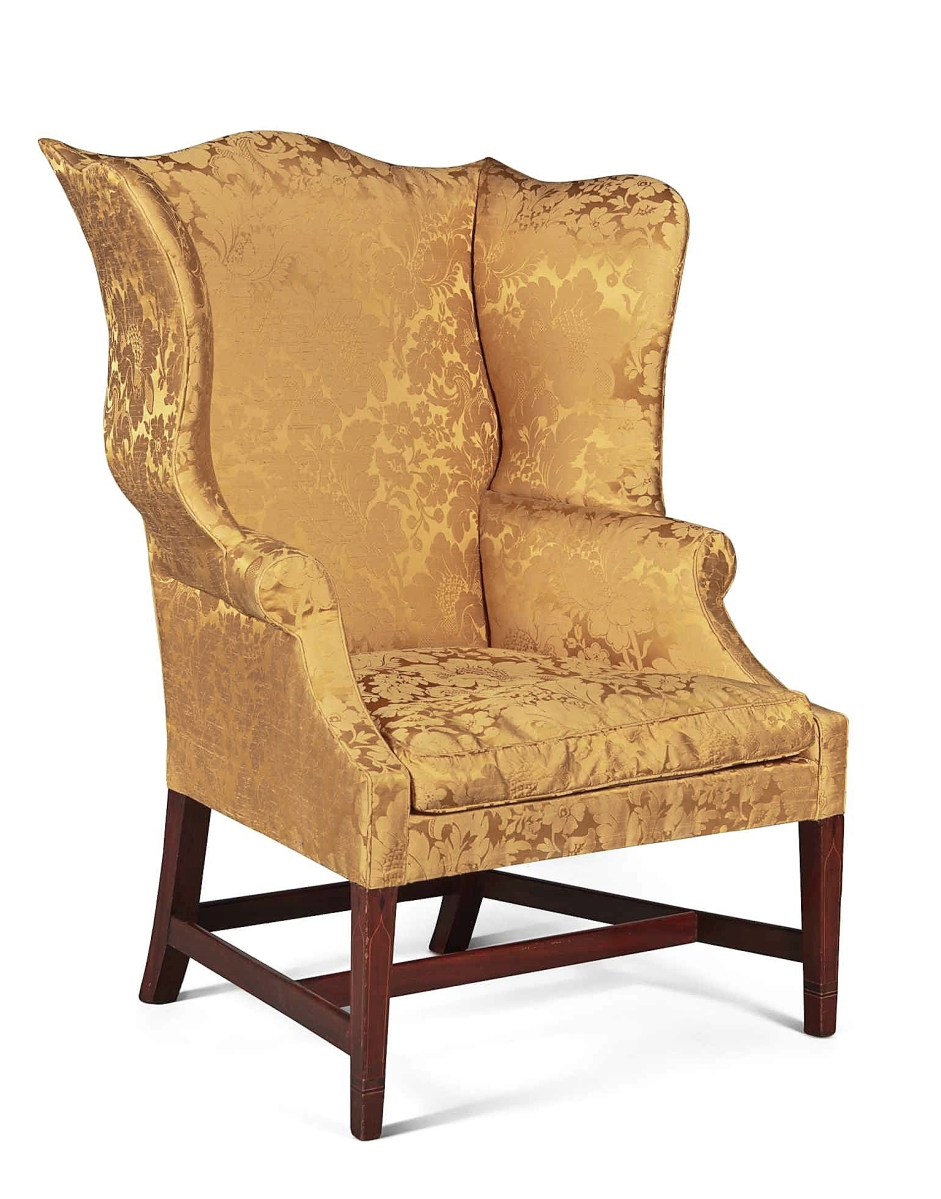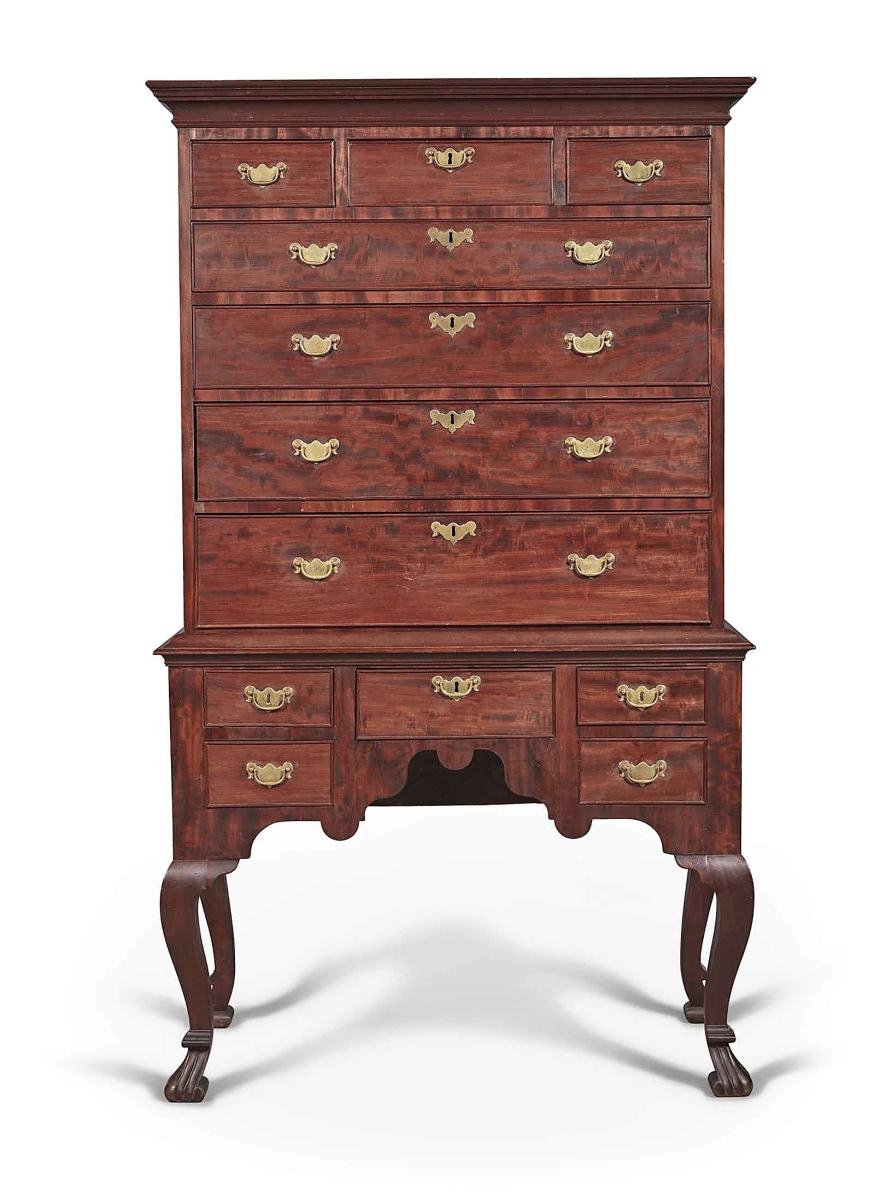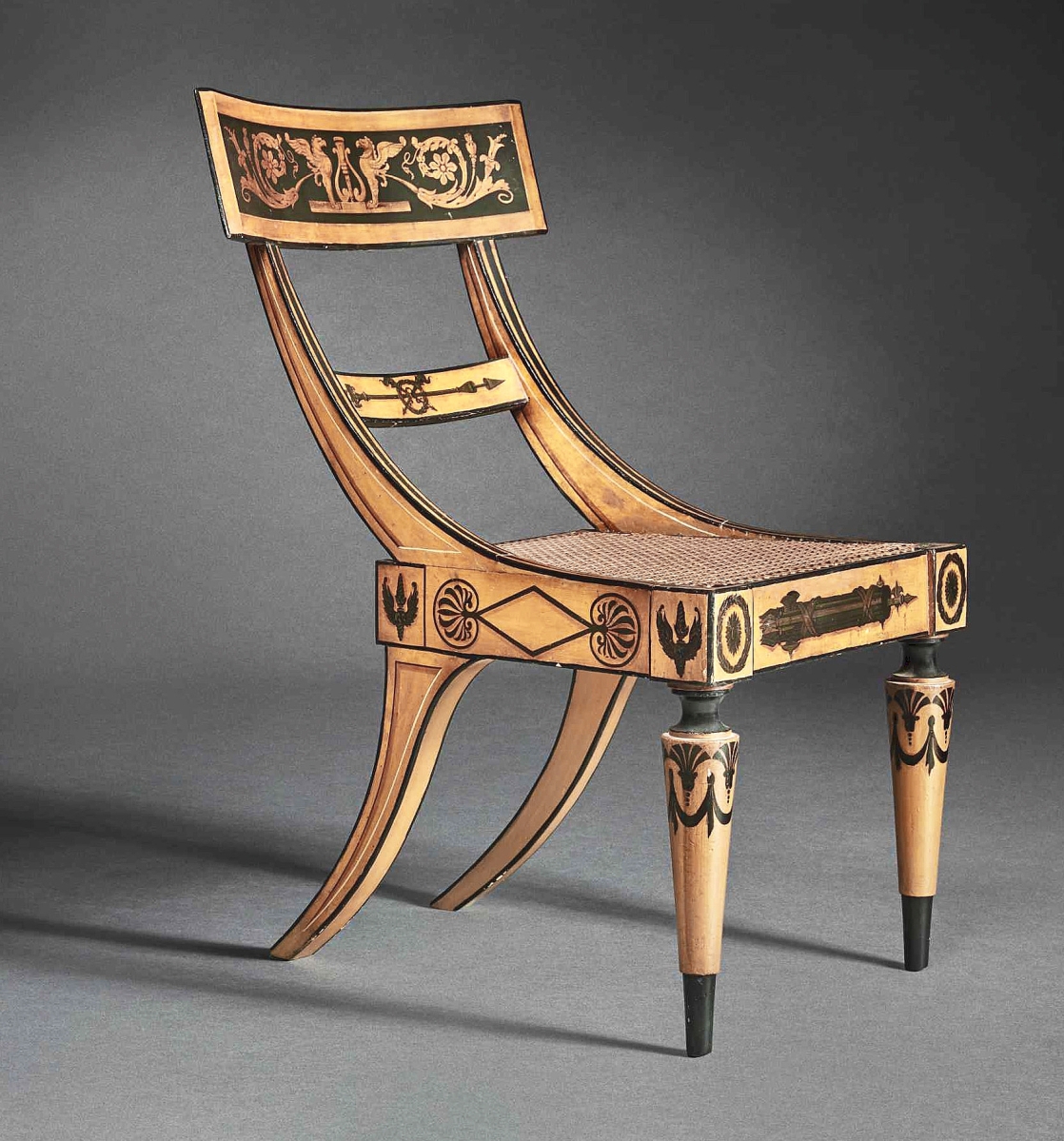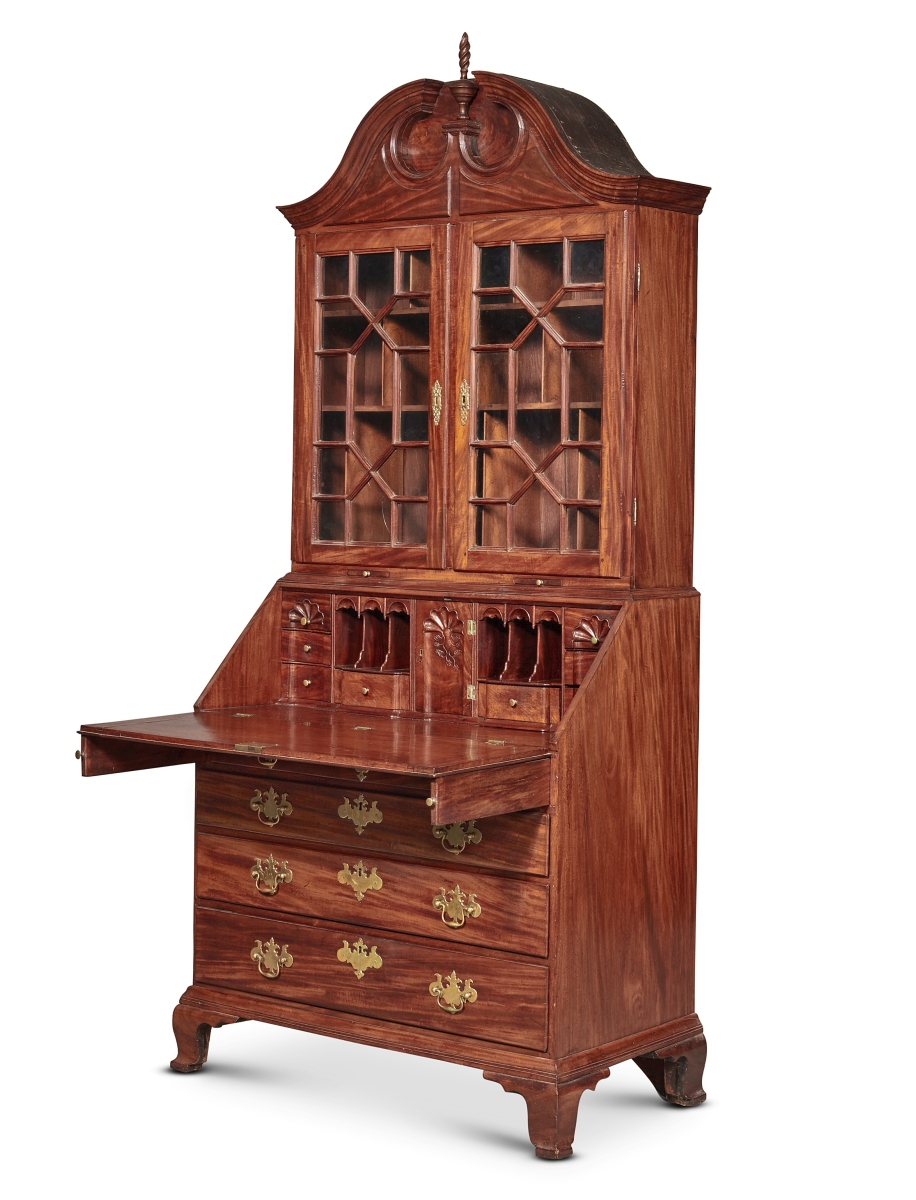
The highest price achieved during Sotheby’s Americana Week was $1,109,000, for this mahogany chest of drawers that was attributed to Daniel Spencer of Providence, R.I. It sold to a private collector ($30/50,000).
Review by Madelia Hickman Ring, Photos Courtesy Sotheby’s
NEW YORK CITY – In the span of five days of auctions spread out during January 19-25, in both live and online formats, Sotheby’s Americana Week offered American furniture, decorative arts, folk art, silver, Chinese export, prints and printed Americana to collectors, dealers and institutions alike. Taking the form of two single owner collections and three various owner sales, the house achieved a total of 1,344 lots. By the time the gavel fell on the final lot of the books, manuscripts and printed American ephemera, the combined total realized was $15,445,032, a number that exceeded the $14.8 million presale aggregate high estimate. Erik Gronning, Sotheby’s senior vice president and head of the American Furniture & Decorative Arts Department, was tired but upbeat when Antiques and The Arts Weekly caught up to him after he’d wrapped up his marathon of sales.
“It really felt like a normal Americana Week. We’d been planning for months, and had contingency plans in place. The galleries weren’t overflowing but there was still a good pull of people throughout. I was really impressed with the breadth of the marketplace. There was activity, interest, strength and vitality across all categories, worldwide. It was a great, and very successful, Americana week.”
Pfaffenroth Collection
Kicking off the auctions was American furniture, silver and decorative arts from the estate collection of Mr and Mrs Peter A. Pfaffenroth. Peter, who died in 2020, had aggressively and passionately collected high-style decorative arts from some of the most prominent makers and urban centers in the Colonial United States. Of the 260 lots that were presented, 243 transacted successfully for a sell-through rate of more than 93 percent, with an aggregate total of $1,473,318.
“Peter bought wonderful, formal furniture. We were able to have conservative estimates and the sale brought in a number of new buyers,” Gronning commented.
One tenth of the sale’s total realized value was achieved in its top lot: a Chippendale carved and figured mahogany pier table with limestone top that had descended in the Holme Family of Philadelphia; the carving had been attributed to the hand of Nicholas Bernard (1732-1789). After heated competition, it sold for $163,800 to a private collector against an estimate of $50/80,000. The table had descended in the Holme family until they sold it at Sotheby’s in 2002, when Pfaffenroth acquired it.
Works made in Philadelphia, or Pennsylvania, were hotly pursued by bidders, with seven of the top ten lots having been made in that area of colonial United States.
A set of four circa 1745 Queen Anne tiger maple chairs, also from Philadelphia, took home the sale’s second highest price: $69,300 and within estimate. The chairs were part of a larger set that Pfaffenroth had painstakingly assembled, buying from dealers and auction houses; they had been part of an exhibition at James Logan’s Stenton in 2017. Stenton ended up purchasing the set of four chairs, as well as a pair of Queen Anne carved and figured walnut compass-seat side chairs, from Philadelphia, circa 1735, for $15,120. The pair, which Pfaffenroth had acquired at a 1994 sale at Sotheby’s, relates to sets with Logan family history.

“That was a very strong price for one without specific ownership,” Erik Gronning said of this enameled gold Order of the Cincinnati, which featured an eagle and soared to $138,600 ($15/25,000).
Other institutions were successful as well. A piece Gronning confirmed sold to museum was a Federal inlaid and figured mahogany and birchwood lady’s secretary, made by George Whitefield Rogers (w 1809-1819), Concord, N.H. The piece had impressive provenance, including Louis Guerineau Myers and Benjamin Flayderman. It had been published in several works on New Hampshire furniture, including Paul Burroughs article “New Hampshire Furniture” in American Collector, June 1937; Currier Gallery of Art’s 1964 exhibition catalog, The Decorative Arts of New Hampshire, 1725-1825, and Plain & Elegant, Rich & Fancy: Documented New Hampshire Furniture, 1750-1850 by Donna-Belle Garvin. Estimated at $8/12,000, the unidentified museum paid $21,420 for it.
For the third highest selling lot of the day, one would not only have to turn to New England but would have to spin the calendar more than 50 years forward. A Federal inlaid and figured mahogany easy chair, attributed to either Boston or Salem, Mass., circa 1805, exceeded expectations when it sold for $37,800. It is the mate to the Howe family chair in the collection at the Museum of Fine Arts, Boston, and had been acquired in 2001 from a sale with Carl Nordblum.
Commentary on other top lots of Philadelphia furniture from Pfaffenroth’s collection would be incomplete without mention of four Chippendale carved mahogany side chairs, possibly from the shop of Thomas Tufft, circa 1770, which had descended in the Tyson and Fitzhugh family of Maryland before Pfaffenroth ultimately acquired them in 2017 from Christie’s. The set sold within estimate for $27,720.
A Queen Anne carved and highly figured mahogany high chest of drawers, attributed to the “Irish Shop” of Philadelphia brought $25,200. The same price was paid for a Chippendale carved and figure mahogany chest on chest attributed to Thomas Affleck that Pfaffenroth had acquired from Philip Bradley Antiques. It was just a little more than the $23,940 paid for a Chippendale figured walnut chest of drawers that had been acquired in 2003 from Bonhams & Butterfield that relates to a diminutive chest with a split top drawer in the collection of the Philadelphia Museum of Art.

This unusually proportioned commemorative 13-star United States flag had once belonged to journalist Charles Kuralt. Bidders raised it to $176,400, the highest price realized in the Books and Manuscripts sale ($15/25,000).
Pfaffenroth’s collection of colonial silver was a small portion of the sale – less than ten percent – but a few pieces realized prices worthy of the leaderboard. The same price of $27,720 was paid for both a teapot bearing the mark of Jacob Gerritse Lansing I of Albany, N.Y., circa 1720-30 and a circa 1710 tankard by Simeon Soumaine of New York City. Works by Boston silversmiths John Coney and Paul Revere were also sought-after by bidders; in the former, a tankard topped off at $20,160, while for the latter, a porringer was scooped up for $17,640. Pfaffenroth’s tall silver coffee pot, made by Joseph and Nathaniel Richardson of Philadelphia, circa 1785, failed to find a buyer.
Last, but certainly not least among Pfaffenroth’s treasures was a carved and figured maple engraved brass flintlock American long rifle made by Nicholas Beyer, Annville Township, Lebanon or Dauphin County, Penn., circa 1790-1810. The rifle, which Pfaffenroth had acquired from Pook & Pook in 2019, blew away its $8/12,000 and sold for $25,200.
William K. du Pont Collection
Arguably the most eagerly awaited collection at Sotheby’s was that of William K. du Pont, who inherited his family’s penchant and eye for collecting. Described in the catalog as the “definition of a true connoisseur, (he) was a devoted scholar and voracious collector” who immersed himself fully in the essence of colonial life.”
It took Sotheby’s four sessions, spread over Saturday and Sunday, January 22-23, to gavel down 640 lots, of which only five lots failed to find buyers. A total of $6,933,844 traded hands with most lots exceeding expectations, sometimes exponentially. According to Sotheby’s press department, 25 percent of the bidders in the du Pont sale were new to Sotheby’s.
“I can’t imagine a better response,” Gronning said. “From the beginning, there were nay-sayers who questioned our decision to sell it all at once, or said ‘who will be there to buy it?’ but there is a very deep market for this, not just in the mid-Atlantic but across the country and around the world. There was something for everyone. Not only did we have a lot of new bidders, but we had a lot of people who hadn’t bought in a while who participated. We did a lot of preemptive things, like traveling highlights to the Delaware Antiques show in November. It was a resounding success and a real testament to Bill’s eye.”
An American carved maple, brass, silver and steel flintlock long rifle made by Martin Fry III of York, Penn, circa 1790, secured the top price of du Pont’s collection at $201,600. The buyer was what Gronning described as “a top American private collector,” who prevailed against competition from institutions and beyond. The gun, which du Pont had acquired from Joe Kindig Jr was considered the finest York school gun in du Pont’s collection and was one of eight rifles on offer in the sale. It epitomized the highest quality craftsmanship in an area rich with gunsmiths and had several features – including a 54¼-inch barrel, 14 silver inlays and a large four-piece pierced and engraved patchbox – that denoted it as a status symbol for a very wealthy gentleman and used for sport shooting. The catalog essay noted that the gun had been illustrated in Kindig’s 1960 tome, Thoughts on the Kentucky Rifle in it’s Golden Age, and had been loaned to German museums by the Kindigs as “the best of American long rifles of its period.”

This engraved steel and silver inlaid poleaxe tomahawk, circa 1770, found a new home for $107,100 (Du Pont Collection, $60/80,000).
Other guns of note in du Pont’s collection included a long rifle made circa 1780 by John Philip Beck (1751-1811) or Lancaster County, Penn., which nearly doubled its high estimate to sell for $94,500. A long rifle made about 25 years late in the Lehigh Valley area and attributed to Jacob Kuntz (1780-1876) or John Rupp the Younger (1762-1836) exemplified the rapid evolution of form that the American long rifle underwent in the Lehigh Valley area in the late Eighteenth Century. Estimated at $40/60,000, it brought $81,900.
Tomahawks were a subcategory within the catalog, with three examples for bidders to battle over. Two realized six-figure prices: a circa 1758 steel pipe tomahawk made in Lancaster County by John Fraser closed at $189,000; for $107,100, an engraved steel and silver inlaid poleaxe tomahawk, circa 1770, went out the door.
A dozen powder horns accompanied the weapons offerings, led at $138,600 by a Revolutionary War example engraved “Liberty or Death” by Jacob Mersereau of New York State and dated 1776. It was followed by General Nathaniel Woodhull’s Engraved French and Indian War map powder horn, New York, and dated 1759; bidders capped it off at $81,900.
Line-and-berry inlaid furniture was a favorite of du Pont and the sale offered nearly a dozen various forms with the distinctive ornamentation, from small and large case pieces to an octagonal stand. Two pieces each earned $151,200: the first being a William and Mary two-part chest from the Delaware River Valley that had been acquired from Bernard & S. Dean Levy and included in the Philadelphia Museum of Art’s 1999 exhibition, “Worldly Goods: The Arts of Early Pennsylvania, 1680-1758.” The other piece to bring that price was the circa 1745 Montgomery family Queen Anne inlaid cherrywood slant front desk-and-bookcase, Nottingham area, Chester County, Penn. It was purportedly du Pont’s favorite piece of line-and-berry inlaid furniture and was cataloged as “the only complete example of its form…that survives.” So rare is this furniture that examples with flaws are forgiven, as evidenced by a William and Mary walnut chest of drawers from Chester County that had replaced feet and base molding that more than tripled its high estimate to finish at $100,800.
Of the five clocks in the sale, a circa 1765 example with works by George Crow of Wilmington, Del., brought the most: $100,800, just on the low estimate. The next highest clock price was $35,280 for a William and Mary walnut tall case clock with works by Peter Stretch of Philadelphia, circa 1715-25, at $35,280.

Jacob Mersereau’s Revolutionary War powder horn, dated 1776 and engraved “Liberty or Death,” was one of a few examples in the du Pont collection. Bidders capped it off at $138,600($20/30,000).
Fine art was largely dominated by fraktur, though the category’s highest price of $100,800 was achieved by “Paul Beck’s Shot Tower” by Thomas Birch (1779-1851), a 31¼-by-41¼-inch work done in oil on canvas laid down on panel. It depicted the 1808 tower that was formerly on the East bank of the Schuykill River between Race and Arch Streets.
Leading the fraktur category, also at $100,800, was Mary Jones’ birth certificate, done in watercolor on paper in 1781 and attributed to the “New Jersey Artist,” of Burlington County, N.J. It was purchased by Woodbury, Conn., folk art dealer, David Schorsch, for stock. It was followed by an 1807 fraktur birth and baptismal certificate, done for Amos Bauer by Christopher Seiler in Dauphin County, Penn. Depicting peacocks and parrots in addition to tulips, it flew to $56,700 from an estimate of $8/12,000.
Du Pont’s collection of candlesticks, mostly early Continental brass examples, was extensive. While most were sold without reserve, the significant majority sold within or above estimates; the group was led at $40,320 by the Governor John Endicott English cast brass “Tudor” “Chalice and Paten” circular-based candlestick from the mid Sixteenth Century. Two other similar examples but without the gubernatorial provenance each fetched $35,280.
Important Americana
A small group – just 44 lots in all – of furniture, silver, printed Americana, fine and folk art, as well as a few small objects, were offered in a live sale the morning of Monday, January 24. Of the 44 lots on offer, 27 sold for an aggregate total of $3,474,280. Despite the comparatively low sell-through rate – not quite 62 percent – it was in this sale that the highest price realized in Americana week was achieved.
A private collector pushed the sale’s high bar to $1,109,000 for a circa 1765 Chippendale block-and-shell carved and figured mahogany chest of drawers attributed to the Providence, R.I., shop of Daniel Spencer (1741-1801). The piece, which had been recently discovered in Paris, was made from vibrantly figured mahogany and retained its original brasses, side carrying handles and unusually large escutcheons.
A pair of Classical yellow, green and gold fancy-painted klismos side chairs and attributed to John Finlay (1777-1851) and/or Hugh Finlay (1781-1831) of Baltimore was sold in two separate, consecutive lots, each estimated at $150/250,000. Gronning justified his decision to separate the pair by saying he thought they would bring more if sold individually; it also increased the opportunity to own one. His decision paid off: the first of the two klismos chairs to cross the block was purchased by a private collector, for $528,200, the second chair found a new home in an as-yet unidentified institution, for $478,800.
The prices realized were some of the highest Gronning could recall for Classical furniture, which were described in the catalog as “supreme examples of Baltimore furniture in the Classical style.” Originally from a larger set of 11 known side chairs possibly made for Arunah Shepherdson Abell (1806-1888) and Mary Fox Abell (1818-1859) of Baltimore that descended in the Griffiss-Fenwick families of Baltimore, the two chairs were the last ones in private hands. Of the original 11, four are in the Metropolitan Museum, a pair is at the Baltimore Museum of Art, the Munson-Williams-Proctor Arts Institute (Utica, N.Y.) has one, as does the High Museum of Art (Atlanta, Ga.). The remaining chair is in the Kaufman Americana Foundation, now at the National Gallery of Art in Washington DC.

Woodbury, Conn., folk art dealer, David Schorsch, prevailed against competition and took Mary Jones’ fraktur birth certificate for $100,800. He was acquiring the 1781 watercolor on paper work for stock (Du Pont Collection, $4/6,000).
Gronning was particularly pleased with the result of a Pilgrim Century joined and turned maple, oak and pine long table from Rhode Island, circa 1680. Nothing says it better than Sotheby’s catalog, which characterized its discovery as “a significant occasion for the American decorative art field.” One of only six known New England examples of this extremely rare form, “it is singular for the presence of a linen drawer.” Though the maker was not identified, the table had an unbroken provenance back to Henry Marchant (1741-1796), the Rhode Island delegate to the Second Continental Congress and a signer of the Articles of Confederation. Estimated at $40/60,000, it brought $94,500.
The Marchant family descendants who sold the table also sold a silver hilted small sword that had been made by Bennett and Son of London, circa 1770. It had originally belonged to Samuel Peckham (1759-1835), a mariner during the American Revolution on the ship Providence under John Paul Jones. The 37-inch sword quickly poked a hole in its $2,5/3,500 estimate and finished at $23,940.
If some of the lots in the sale failed to find buyers, Gronning was able to close the deal with some successful post-auction transactions. Among these was a Chippendale sulfur-inlaid walnut cradle from Lancaster, Penn., that was dated 1782 and was a new discovery. It had been estimated at $30/50,000 but Gronning found a new home for it with an unidentified institution, at an undisclosed price.
The Important Americana sale was an ideal place to offer higher-valued printed ephemera, fine art and Chinese export that benefitted from a live audience. Among the notable results were the $88,200 realized by a Paul Revere’s 1770 engraving titled, “The Bloody Massacre perpetrated in King Street Boston on March 5th 1770 by a party of the 29th Reg’t.” A rare Qing dynasty view of the American settlement in Shanghai, circa 1863, also surpassed expectations, bringing $69,300 against an estimate of $30/50,000.

Selling for $27,720 was this large tankard made around 1710 by New York silversmith Simeon Soumaine (Pfaffenroth Collection, $20/30,000).
Various Owners’ Americana, Furniture, Folk Art, Chinese Export, Prints & Silver
Sotheby’s considered the 2021 online-only Americana Week sales such a success that they offered a final selection of Americana, furniture, folk art, Chinese export, prints and silver in an online-only auction on Monday afternoon, January 24. Of the nearly 250 lots offered, more than 80 percent were sold for a total of $1,674,422.
The top price in the online-only sale was $226,800, achieved for a portrait of Ulysses S. Grant by Stephen William Shaw (1817-1900). It had come down in Grant’s family and was considered unusual because it did not depict Grant as president. It also set a new record for the artist.
Grant’s descendants also sold an American Aesthetic Movement silver five-piece tea and coffee set with matching tray, made by the Providence, R.I., company Gorham, between 1877 and 1880. At $56,700, not only was it the top price for a lot of silver but it was the third highest value in the sale.
Another particularly strong price was secured by a rare Order of the Cincinnati medal attributed to Jeremiah Andrews who worked in Philadelphia, 1784-91, then subsequently in Norfolk, Va., from 1791 to 1817. Most Orders of the Cincinnati come with firm provenance; this one did not and Gronning said the $138,600 it brought was “a very strong price for one without specific ownership.” It also earned the medal second-place honors in the online sale.

Paul Revere’s “The Bloody Massacre perpetrated in King Street Boston” is a perennial favorite among bidders. This example fetched $88,200 ($40/60,000).
Fine Books and Manuscripts, Including Americana
A final session of 158 lots, offered online only, and concluding on Tuesday, January 25, featured American books and manuscripts; it tallied $1,889,168. Bringing in the top lot at $176,400 was a commemorative 13-star pre-Civil War flag that had provenance to the collection of journalist Charles Kuralt, who is perhaps best known for his long-running TV feature “On the Road.” The flag was sold to benefit the Dorothy Tapper Goldman Foundation.
Prices quoted include the buyer’s premium as reported by the auction house.
Sotheby’s will next sell Americana in January 2023. For information, www.sothebys.com.





































